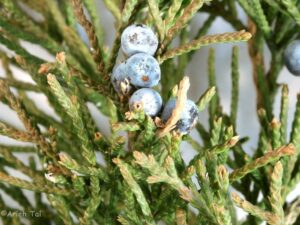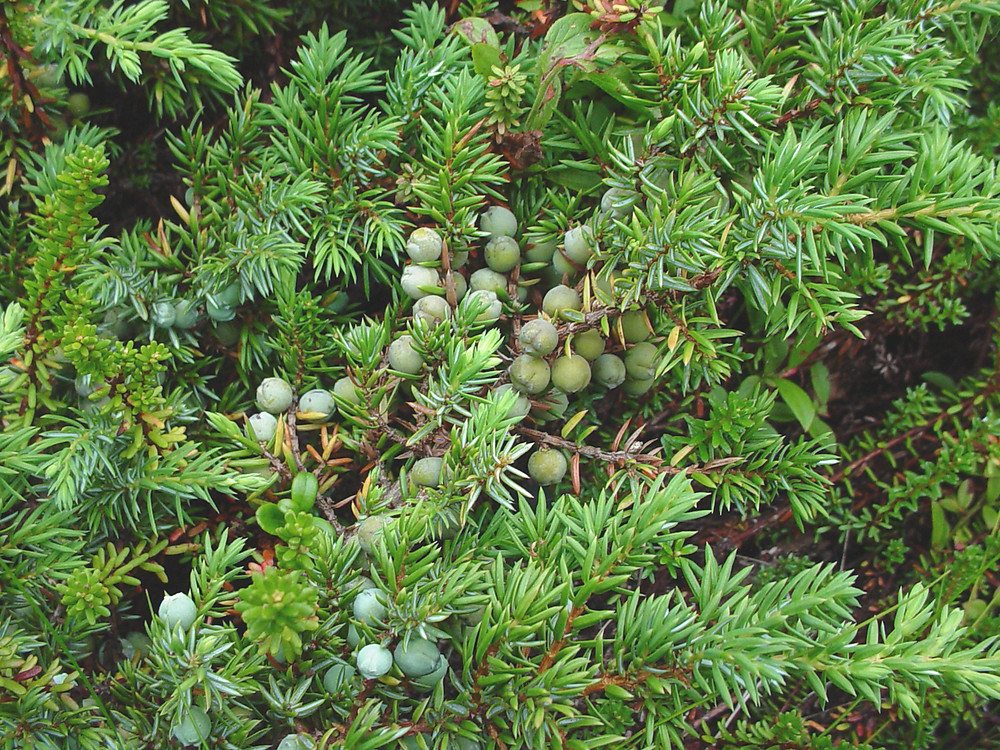It never ceases to amaze me as I continue to learn about the different plants that we have around us all the time and that are useful. Today I am talking about the common Juniper plant. The ones you see in so many yards. I am sure you have all seen the juniper berries that grow on them. But did you know that they are a common spice used in Northern European and Scandinavian food as a seasoning.
Juniper berries are used in meat dishes, especially wild birds and game meats including wild boar and venison. They are also used to season pork, cabbage, and sauerkraut dishes. Juniper is the flavoring used to give the taste to gin.
In North America, there are 13 indigenous species that grow wild, and more that are commercially cultivated varieties. Some are too bitter to eat. The juniper that grows most often in the wild in central and eastern North America is called eastern red cedar (Juniperus virginiana). The berries take two or three years to ripen. They will be blue-black with a whitish bloom, and are most aromatic when fresh. Edible species include J. communis, (the common juniper) J. drupacea (Syrian juniper), J. oxycedrus (prickly juniper), J. phoenicea (Phoenicean juniper), J. deppeana (wild juniper or alligator juniper which drops its waxy berries), J. virginiana (Eastern red cedar or red cedar juniper) and J. californica (California juniper).

Juniper berries are the female seed cone produced by the various species and not a real berry. All juniper species grow berries, but some are quite bitter. In an emergency such as being lost in the woods you can eat the berries right off the bushes. But it is not advisable to eat large quantities of them as they can cause kidney problems and can cause contractions in pregnant women. They are also a strong diuretic. They are more of a seasoning than a main dish.
The whitish blush on the outside of juniper berries is wild yeast. You can make a sourdough starter by mixing a cup of flour, three or four berries and 1/4 cup water in a glass jar. Let sit in a warm place, loosely covered, until the mixture begins to form. Remove the berries and use the starter as you would any other sourdough starter.
Many Native American tribes used the Juniper berries in various ways. In California and the South West, some tribes mixed the berries with chopped meat, put it into a clean deer stomach and then roasted it all. Others pulverized the berries, soaked them in water, sucked out the juice, some just eat them fresh. But the others deseeded the berries, pounded them into meal, moistened and formed the meal into cakes, dried them then ate them.
Juniper berries are also used as a medication. They were also used for digestion problems including upset stomach, intestinal gas, heartburn, and loss of appetite, as well as gastrointestinal (GI) infections and intestinal worms. Some people applied juniper directly to the skin for wounds and for pain in joints and muscles. Juniper berry might lower blood sugar. But some medical authorities stated that there is some concern that it might lower blood sugar too much in people with diabetes.
As I do every time I write about edible plants, be sure you have correctly identified the plants prior to consuming them. If the shrub is a needle-leafed evergreen with red berries, it is a yew, and its berries could cause you to die. Get a good plant book and be sure you know what you are doing.
Howard


[lasso rel="emergency-preparedness-more-a-manual-on-food-storage-and-survival-2nd-edition-revised-and-updated" id="35334"]